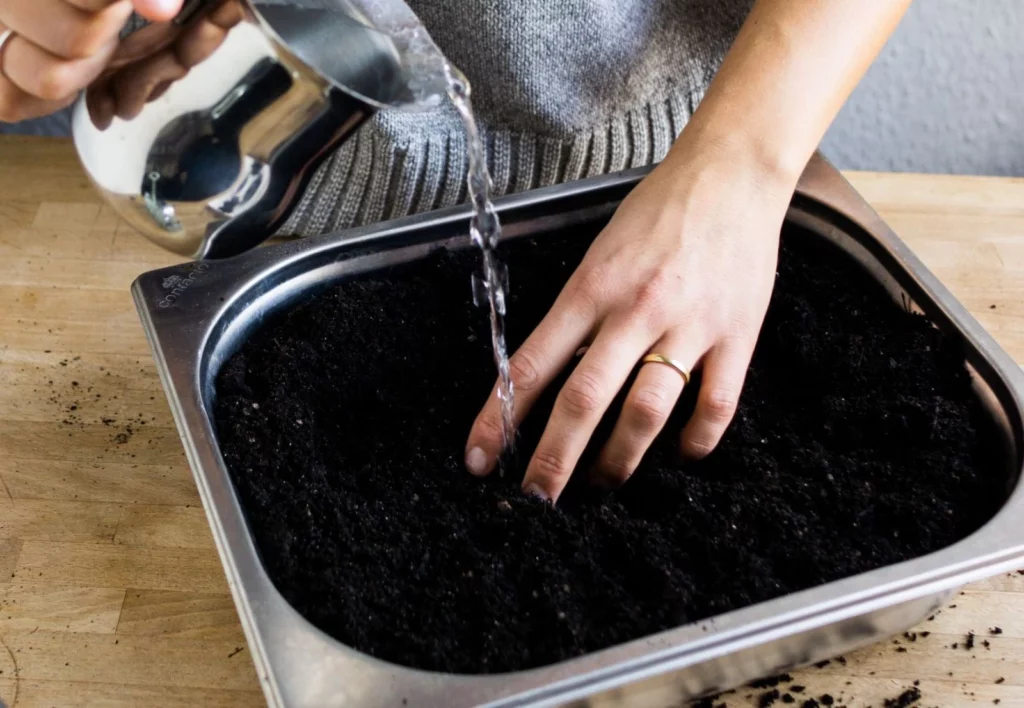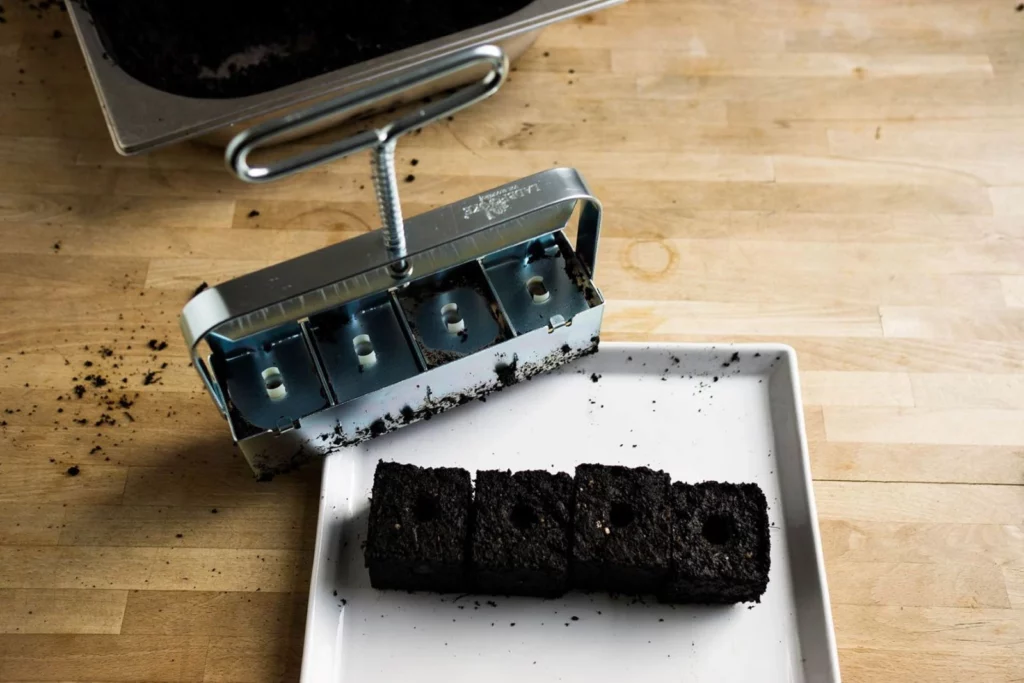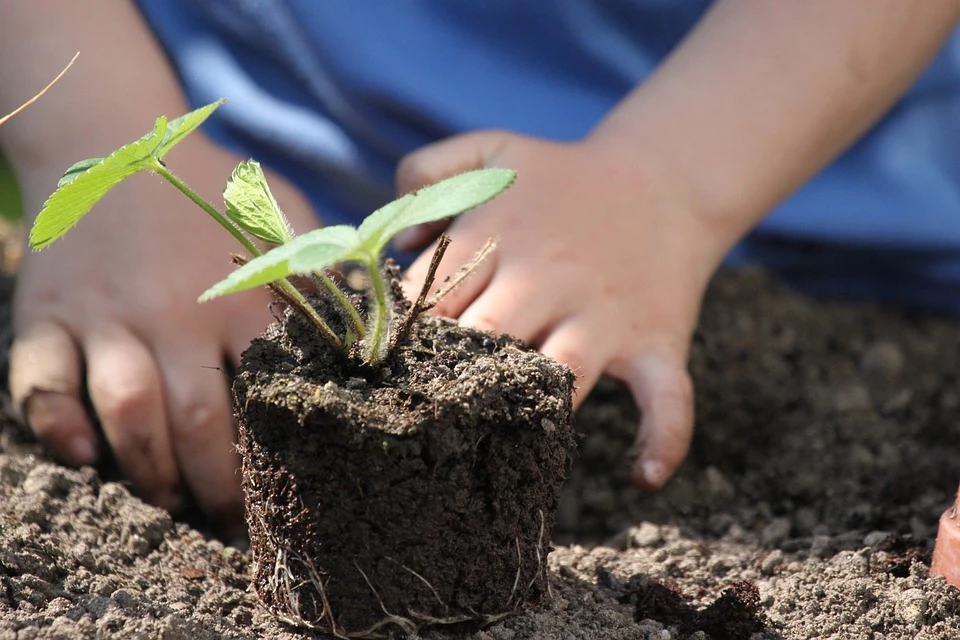Growing soil, also called sowing soil, is very easy to make yourself. This is not only sustainable, but also saves money! In this article we will show you what you need to consider when making the growing medium and how best to proceed.
- Mix 1/3 each of sifted garden soil, sifted, matured compost and sand
- add rock flour/algal lime if required
- sterilize at 120 °C for 45 min in the oven
- then let cool down, can be used directly
Contents
Growing soil – What is it?
There are many reasons for using special potting soil. Firstly, sowing soil is quite rich in humus, which is why it has a fine crumbly structure. This makes it easier for the delicate seedlings to reach the surface without hurting themselves or being held up by heavy lumps of clay. Besides, the roots can spread better and grow through the growing pot. This is important, because a strong root system is later crucial for the absorption of water and nutrients. The humus-containing sowing soil can also store a lot of water, which means that the young plants are supplied with water more evenly and do not dry out as quickly. At the same time, the loose structure of the growing medium allows sufficient oxygen to reach the roots, which the root cells need to breathe.
Why you should make your own potting soil
Purchased growing soil, potting soil or vegetable soil often contains peat. It is rich in nutrients and provides a loose soil with a high water-holding capacity. Peat comes from bogs, which must be drained for decomposition. This allows oxygen to reach the stored carbon compounds in the peat soil. The result: masses of CO2 are released. Normally, peatlands are good CO2 sinks, because the low-oxygen environment in the soil causes plants and thus the carbon bound in them to be stored in the soil. Peat cutting produces many greenhouse gases that are harmful to the climate. In Europe alone, peat cutting accounts for around 7% of greenhouse gas emissions (bund-niedersachsen.de). In addition, peat cutting destroys important habitats for adapted, rare animal and plant species. If you make your own growing soil, you can determine which components you use!
Besides, you can control what consistency your sowing soil should have and ensure that it does not harbor dangerous germs by sterilizing it in the oven.
Composition of your own potting soil
To make your own growing soil, you’ll need three main ingredients: well-matured compost, garden soil (preferably from your own garden) and sand.
Here is the exact composition:
- 1 part well-matured compost
- 1 part sand (preferably of medium grain size)
- 1 part loose garden soil
The right compost
The compost component should be well-matured compost, because it is well decomposed. For this purpose, the compost soil should be deposited for 2-3 years at best. As a result, it has a fine crumbly structure and also contains fewer nutrients due to the long maturation. The low nutrient content is important for the young plants, because this stimulates the seedlings to form stronger roots. This makes the plants more resistant and better supplied with nutrients later on. So your harvest already depends on the growing soil!
The right garden soil
First, you should know what kind of garden soil you have. Find out how your garden soil is composed in our simple soil test. In addition, indicator plants can also give you clues about your garden soil. If it is very heavy (clayey, loamy), it is not so well suited for the production of sowing soil. It can easily form clumps because it becomes very hard when it dries, making it difficult for the little plants to grow roots. Very light, sandy garden soil is also not ideal, because it dries out very quickly. So a silty, medium-heavy garden soil is best. You can collect such a great, loose soil from molehills, for example.

Recipe: Homemade potting soil
First, sift compost and garden soil to create a fine structure. It is best to sort out coarser components such as plant or root remains and seeds. Then mix garden soil, compost and sand properly so that a homogeneous mass is created. If you like, you can also mix some rock flour or algae lime into the growing soil, so that the seedlings receive important micronutrients early on. To ensure that no germs or pests endanger your seedlings, you should also sterilize the mixture. To do this, place it in the oven at approx. 120 °C for approx. 45 min. Afterwards you can use the soil directly for your cultivation. The sterilization process makes the soil very dry. Therefore, moisten it carefully and knead it like a dough until the potting soil has the desired consistency.
Is potting soil also herbal soil?
Basically, your homemade potting soil can also be used as a substrate for herbs. Most herbs, just like young plants, require a nutrient-poor and crumbly soil. Mediterranean herbs usually prefer lime-rich, alkaline soil. Here, you should add a handful of magnesium lime to your homemade growing medium.
Herbs with low nutrient needs:
- Savory
- Lavender
- Oregano/Marjoram
- Rosemary
- Sage
- Thyme
However, some herbs do better in more nutrient-rich substrates. They need soil that can store nutrients and water well. Here, you should either fertilize your herb soil regularly or mix in fresher compost.
Herbs with higher nutrient requirements
- Basil
- Borage
- Dill
- Tarragon
- Coriander
- Lovage
- Melissa
- Mint
- Parsley

Tips for growing
If you want to save space and waste, you can try a soil pot press. With this you can easily and quickly press small growing cuboids (soil pots) from (homemade) growing soil, which you can use like growing pots. You can place these super space-saving close together on a base and do not have to buy extra plastic growing pots.
Always make sure that your young plants are supplied with sufficient water, because the small plants with their meager root system dry out quickly in the beginning. However, the pots should not stand in water, otherwise too little oxygen reaches the roots and the plants die.
Not all plants need to be grown in advance. In our article we tell you which plants should be grown in advance and which should be sown directly.


